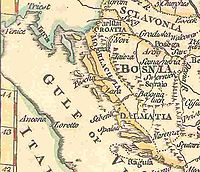Morlachs
| Regions with significant populations | |
|---|---|
| western Balkans | |
| Languages | |
| Vlach and other languages in the areas in which they lived | |
| Religion | |
| Eastern Orthodoxy (mostly) and Roman Catholic | |
| Related ethnic groups | |
| • Vlachs • Serbs
• Croats |

Morlachs (Mauro-Vlachs or Mavrovlachi, also Nigri Latini in Latin sources, meaning "Black Vlachs"; in Greek: Μαυροβλάχοι, in Serbian and Croatian Morlaci [mor-latsi] or Морлаци) were a population of Vlachs. In another version their name comes from the slavic terms of "morski-Vlasi" or Sea Vlachs. The morlachs were shepherds that lived in the Dinaric Alps (western Balkans in modern use), seasonally migrating in search for better pastures for their sheep flocks (between mountains, in the summertime, and the sea shores, in the wintertime). They were a blend of previously Romanized indigenous peoples and new settled Roman army veterans and Roman colonists.
The adjective "black" may be used here with the meaning of "northern", this metaphor probably deriving from the Turkish practice of indicating cardinal directions by colors.
Reports from the mid-11th century tell how the Morlachs lived in the mountainous regions of Montenegro, Stari Vlah of Serbia, Bosnia, and Herzegovina. In the 14th century, some Morlachs moved northward and settled in present-day Croatia where later they would serve as frontier guardians in the Military Frontier between the Habsburg (Croatia) and the Ottoman (Bosnia) Empires, an area sometimes known as Morlachia, also see House of Keglević. The continuous attempts by the foreign feudal lords to reduce them to serfdom failed. It is not clear as yet exactly how the Morlachs survived, but the slower feudalization of the Western Balkans compared to the west of Europe seem to alleviate their decentralization from the feudal bonds. Greater freedom and easier mobility into the mountains of the Morlachs, continuously attracted the running Slavic serfs asking for protection, and eventually most Morlachs were linguistically assimilated by the local Slavs.
In the 15th century, a first group of Morlachs were invited to settle into the Istrian Peninsula after the various devastations of the plague between 1500–1600. In 1525, a group settled in the outskirts of then Rovigno (today's Rovinj), so their descendants are sometimes erroneously confused with the Istro-Romanians who are "cici" and "vlahi", a distinctly different Romanized group from the Morlachs [citation needed]. With no more than a thousand speakers of Istro-Romanian believed to remain in Istria, the language has been called for centuries "rumeno" and "istrorumeno" by the native speakers and "rumunski" and "istrorumunski" by the Slavs, is on the verge of extiction. Misnomering their language with "vlaški" and "zejanski", Slavic rather than equivalent Romanian names - as well as disrespectlessly nicknaming it as "ciri-biri" - ensures that the absorption is virtually guaranteed. Various independent efforts to salvage this unique language (a dialect of Romanian) are not unified and their success is doubtful.
Another group of "vlahi" reached the island of Krk (it. Veglia) around 1450 and settled in the villages of Dubašnica and Poljica, where until the 19th century the people spoke an Italic language called Vegliot but which is not the same language as Istro-Romanian.
In the 18th century, Alberto Fortis visited the Morlachs and found that they sang beautiful verses of epic poetry related to the Turkish occupation of Serbian Kosovo. They sang the verses along with the traditional single stringed instrument called gusle [goo-slae]. This poetry was collected by the Scottish man-of-letters Lord Bute, who was close to King George III.
Outside Istria, the term Morlach continues to describe the people of Dalmatia, Zagora and Lika and the former region known as Morlachia.
According to the 1991 Croatian census, 22 people declared themselves as Morlachs. [citation needed]
There is no data on Morlachs in the 2001 Croatian census, but the number of Morlachs are estimated to grown to over 100 persons since then. [citation needed] For Morlachs in Croatia and the Balkans to reappear as an ethnolinguistic group, they have to organize social groups and make efforts to promote their language and culture. [citation needed]
